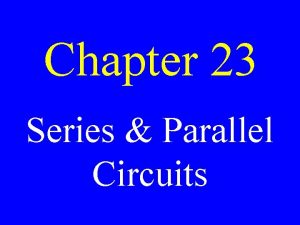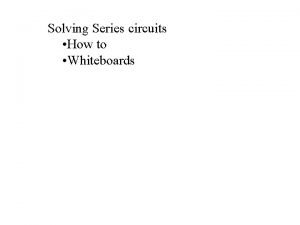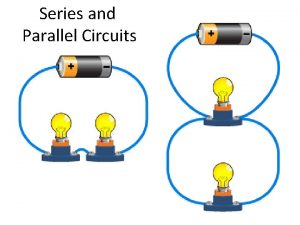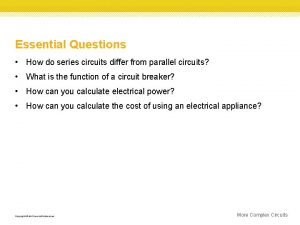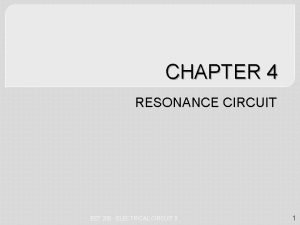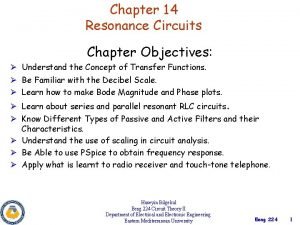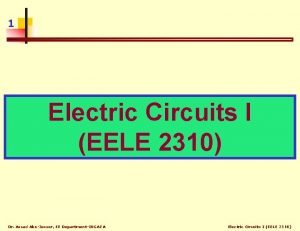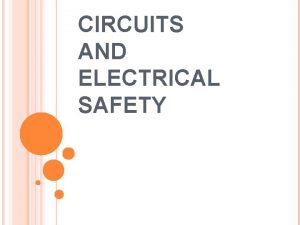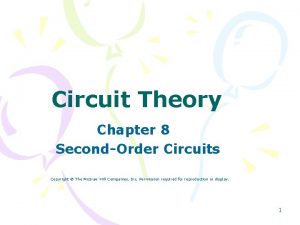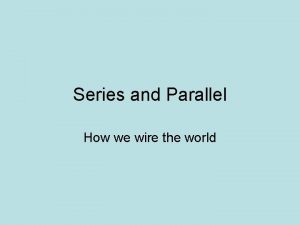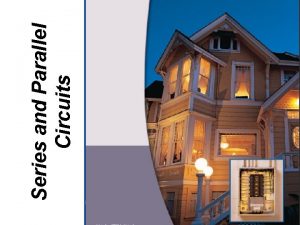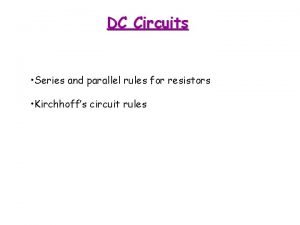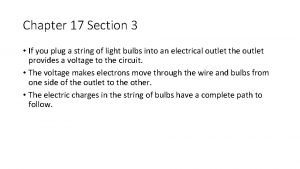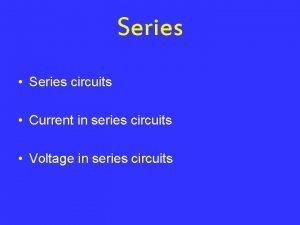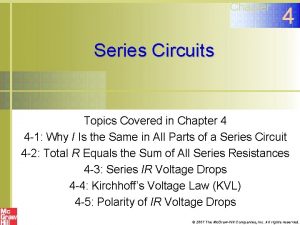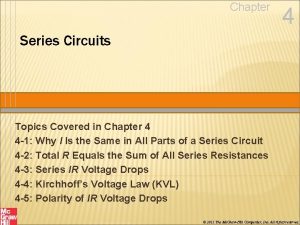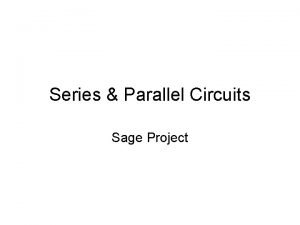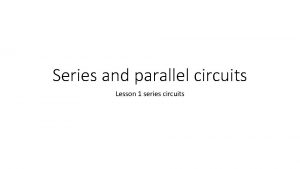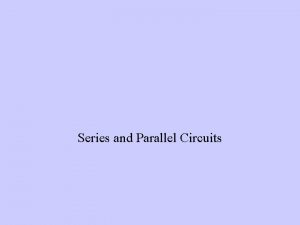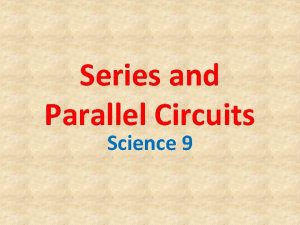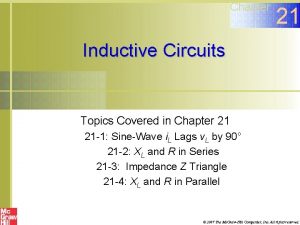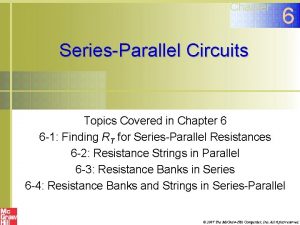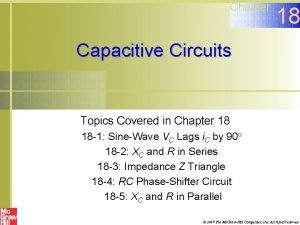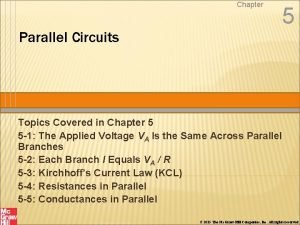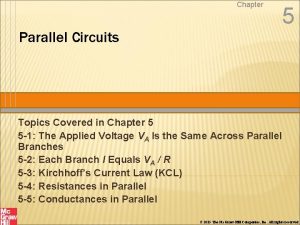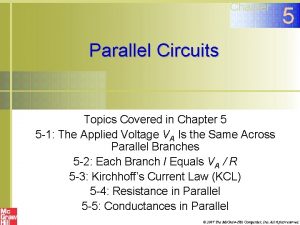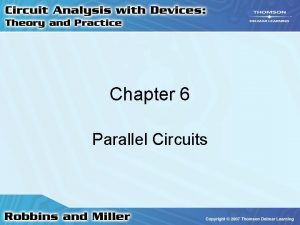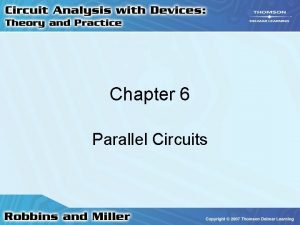Chapter 4 Series Circuits Topics Covered in Chapter



































- Slides: 35

Chapter 4 Series Circuits Topics Covered in Chapter 4 4 -1: Why I Is the Same in All Parts of a Series Circuit 4 -2: Total R Equals the Sum of All Series Resistances 4 -3: Series IR Voltage Drops 4 -4: Kirchhoff’s Voltage Law (KVL) 4 -5: Polarity of IR Voltage Drops © 2015 The Mc. Graw-Hill Companies, Inc. All rights reserved.

TOPICS COVERED IN CHAPTER 4 4 -6: Total Power in a Series Circuit 4 -7: Series-Aiding and Series-Opposing Voltages 4 -8: Analyzing Series Circuits with Random Unknowns 4 -9: Ground Connections in Electrical and Electronic Systems 4 -10: Troubleshooting: Opens and Shorts in Series Circuits Mc. Graw-Hill © 2015 The Mc. Graw-Hill Companies, Inc. All rights reserved.

4 -1: WHY I IS THE SAME IN ALL PARTS OF A SERIES CIRCUIT Characteristics The of a Series Circuit current is the same everywhere in a series circuit. The total resistance is equal to the sum of the individual resistance values. The total voltage is equal to the sum of the IR voltage drops across the individual resistances. The total power is equal to the sum of the power dissipated by each resistance.

4 -1: WHY I IS THE SAME IN ALL PARTS OF A SERIES CIRCUIT Current is the movement of electric charge between two points, produced by the applied voltage. The free electrons moving away from one point are continuously replaced by free electrons flowing from an adjacent point in the series circuit. All electrons have the same speed as those leaving the voltage source. Therefore, I is the same in all parts of a series circuit.

4 -1: WHY I IS THE SAME IN ALL PARTS OF A SERIES CIRCUIT Fig. 4 -2: There is only one current through R 1, R 2, and R 3 in series. (a) Electron drift is the same in all parts of a series circuit. (b) Current I is the same at all points in a series circuit. Copyright © The Mc. Graw-Hill Companies, Inc. Permission required for reproduction or display.

4 -1: WHY I IS THE SAME IN ALL PARTS OF A SERIES CIRCUIT Series Current Formulas Total current is the same as the individual currents in the series string: IT = I 1 = I 2 = I 3 =. . . = etc. Total current is equal to total voltage divided by total resistance: VT IT = RT

4 -2: TOTAL R EQUALS THE SUM OF ALL SERIES RESISTANCES When a series circuit is connected across a voltage source, the free electrons must drift through all the series resistances. There If is only one path for free electrons to follow. there are two or more resistances in the same current path, the total resistance across the voltage source is the sum of all the resistances.

4 -2: TOTAL R EQUALS THE SUM OF ALL SERIES RESISTANCES Fig. 4 -4: Series resistances are added for the total RT. (a) R 1 alone is 3 Ω. (b) R 1 and R 2 in series together total 5 Ω. (c) The RT of 5 Ω is the same as one resistance of 5 Ω between points A and B. Copyright © The Mc. Graw-Hill Companies, Inc. Permission required for reproduction or display.

4 -2: TOTAL R EQUALS THE SUM OF ALL SERIES RESISTANCES Series Resistance Formulas The total resistance is the sum of the individual resistances. R 1 R 2 R 5 R 4 R 3 RT = R 1 + R 2 + R 3 + R 4 + R 5

4 -2: TOTAL R EQUALS THE SUM OF ALL SERIES RESISTANCES Series Resistance Formulas Total resistance is equal to total voltage divided by the circuit current: VT RT = IT

4 -2: TOTAL R EQUALS THE SUM OF ALL SERIES RESISTANCES Determining the Total Resistance

4 -3: SERIES IR VOLTAGE DROPS By Ohm’s Law, the voltage across a resistance equals I × R. In a series circuit, the IR voltage across each resistance is called an IR drop or voltage drop. It is so called because it reduces the potential difference available for the remaining resistances in the circuit.

4 -3: SERIES IR VOLTAGE DROPS Fig. 4 -5: An example of IR voltage drops V 1 and V 2 in a series circuit. Copyright © The Mc. Graw-Hill Companies, Inc. Permission required for reproduction or display.

4 -4: KIRCHHOFF’S VOLTAGE LAW (KVL)

4 -4: KIRCHHOFF’S VOLTAGE LAW (KVL) The IR drops must add to equal the applied voltage (KVL). 10 W 15 W VT = 10 V 1 25 W V 5 V 2 20 W 0. 1 A V 3 30 W V 4 VT = V 1 + V 2 + V 3 + V 4 + V 5 VT = IR 1 + IR 2 + IR 3 + IR 4 + IR 5 VT = 0. 1 × 10 + 0. 1 × 15 + 0. 1 × 20 + 0. 1 × 30 + 0. 1 × 25 VT = 1 V + 1. 5 V + 2 V + 3 V + 2. 5 V = 10 V

4 -5: POLARITY OF IR VOLTAGE DROPS When current flows through a resistor, a voltage equal to IR is dropped across the resistor. The polarity of this IR voltage drop is: Negative at the end where the electrons enter the resistor. Positive at the end where the electrons leave the resistor.

4 -5: POLARITY OF IR VOLTAGE DROPS The rule is reversed when considering conventional current: positive charges move into the positive side of the IR voltage. The polarity of the IR drop is the same, regardless of whether we consider electron flow or conventional current.

4 -5: POLARITY OF IR VOLTAGE DROPS Fig. 4 -8: Polarity of IR voltage drops. (a) Electrons flow into the negative side of V 1 across R 1. (b) Same polarity of V 1 with positive charges moving into the positive side. Copyright © The Mc. Graw-Hill Companies, Inc. Permission required for reproduction or display.

4 -6: TOTAL POWER IN A SERIES CIRCUIT The power needed to produce current in each series resistor is used up in the form of heat. The total power used in the circuit is equal to the sum of the individual powers dissipated in each part of the circuit. Total power can also be calculated as VT × I Fig. 4 -10: The sum of the individual powers P 1 and P 2 used in each resistance equals the total power PT produced by the source. Copyright © The Mc. Graw-Hill Companies, Inc. Permission required for reproduction or display.

4 -6: TOTAL POWER IN A SERIES CIRCUIT Finding Total Power 10 W P 1 VT = 10 25 W P 5 15 W P 2 0. 1 A 20 W P 3 30 W P 4 PT = P 1 + P 2 + P 3 + P 4 + P 5 PT = I 2 R 1 + I 2 R 2 + I 2 R 3 + I 2 R 4 + I 2 R 5 PT = 0. 1 W + 0. 15 W + 0. 2 W + 0. 3 W + 0. 25 W = 1 W Check: PT = VT × I = 10 V × 0. 1 A = 1 W

4 -7: SERIES-AIDING AND SERIES-OPPOSING VOLTAGES Series-aiding voltages are connected with polarities that allow current in the same direction: The positive terminal of one is connected to the negative terminal of the next. They can be added for the total voltage.

4 -7: SERIES-AIDING AND SERIES-OPPOSING VOLTAGES Series-opposing voltages are the opposite: They are connected to produce opposing directions of current flow. The positive terminal of one is connected to the positive terminal of another. To obtain the total voltage, subtract the smaller voltage from the larger. Two equal series-opposing voltage sources have a net voltage of zero.

4 -7: SERIES-AIDING AND SERIES-OPPOSING VOLTAGES Fig. 4 -11: Example of voltage sources V 1 and V 2 in series. (a) Note the connections for seriesaiding polarities. Here 8 V + 6 V = 14 V for the total VT. (b) Connections for series-opposing polarities. Now 8 V – 6 V = 2 V for VT. Copyright © The Mc. Graw-Hill Companies, Inc. Permission required for reproduction or display.

4 -8: ANALYZING SERIES CIRCUITS WITH RANDOM UNKNOWNS When trying to analyze a series circuit, keep the following principles in mind: 1. 2. If I is known for one component, use this value in all components. The current is the same in all parts of a series circuit. If I is unknown, it may be calculated in one of two ways: Divide VT by RT Divide an individual IR drop by its R. Remember not to mix a total value for an entire circuit with an individual value for part of the circuit.

4 -8: ANALYZING SERIES CIRCUITS WITH RANDOM UNKNOWNS 3. If all individual voltage drops are known, add them to determine the applied VT. A known voltage drop may be subtracted from VT to find a remaining voltage drop.

4 -9: GROUND CONNECTIONS IN ELECTRICAL AND ELECTRONIC SYSTEMS In most electrical and electronic systems, one side of the voltage source is connected to ground. The reason for a ground connection is to reduce the possibility of electric shock.

4 -9: GROUND CONNECTIONS IN ELECTRICAL AND ELECTRONIC SYSTEMS Figure 4 -16 shows several schematic ground symbols: Ground is assumed to have a potential of 0 V regardless of the schematic symbol shown. These symbols are sometimes used inconsistently with their definitions. However, these symbols always represent a common return path for current in a given circuit. Copyright © The Mc. Graw-Hill Companies, Inc. Permission required for reproduction or display.

4 -9: GROUND CONNECTIONS IN ELECTRICAL AND ELECTRONIC SYSTEMS Voltages When Measured with Respect to Ground a circuit has a ground as a common return, measure the voltages with respect to this ground.

4 -9: GROUND CONNECTIONS IN ELECTRICAL AND ELECTRONIC SYSTEMS Fig. 4 -18: An example of how to calculate dc voltages measured with respect to ground. (b) Negative side of VT grounded to make all voltages positive with respect to ground. (d) Positive side of VT grounded, all voltages are negative to ground. Copyright © The Mc. Graw-Hill Companies, Inc. Permission required for reproduction or display.

4 -10: TROUBLESHOOTING: OPENS AND SHORTS IN SERIES CIRCUITS The Effect of an Open in a Series Circuit An open circuit is a circuit with a break in the current path. When a series circuit is open, the current is zero in all parts of the circuit. The total resistance of an open circuit is infinite ohms. When a series circuit is open, the applied voltage appears across the open points.

4 -10: TROUBLESHOOTING: OPENS AND SHORTS IN SERIES CIRCUITS The Effect of an Open in a Series Circuit Fig. 4 -19: Effect of an open in a series circuit. (b) Open path between points P 1 and P 2 results in zero current in all parts of the circuit. Copyright © The Mc. Graw-Hill Companies, Inc. Permission required for reproduction or display.

4 -10: TROUBLESHOOTING: OPENS AND SHORTS IN SERIES CIRCUITS Applied voltage VT is still present, even with zero current. The voltage source still has its same potential difference across its positive and negative terminals. Example: The 120 -V potential difference is always available from the terminals of a wall outlet. If an appliance is connected, current will flow. If you touch the metal terminals when nothing else is connected, you will receive a shock.

4 -10: TROUBLESHOOTING: OPENS AND SHORTS IN SERIES CIRCUITS The Effect of a Short in a Series Circuit When part of a series circuit is shorted, the current flow increases. When part of a series circuit is shorted, the voltage drops across the non-shorted elements increase. The voltage drop across the shorted component drops to 0 V.

4 -10: TROUBLESHOOTING: OPENS AND SHORTS IN SERIES CIRCUITS The Effect of a Short in a Series Circuit Fig. 4 -21: Series circuit of Fig. 4 -19 with R 2 shorted. Copyright © The Mc. Graw-Hill Companies, Inc. Permission required for reproduction or display.

4 -10: TROUBLESHOOTING: OPENS AND SHORTS IN SERIES CIRCUITS When troubleshooting a series circuit containing three or more resistors, remember: The component whose voltage changes in the opposite direction of the other components is the defective component.
 Advantages of parallel circuit over series circuit
Advantages of parallel circuit over series circuit What topics will be covered in this unit
What topics will be covered in this unit Chapter 23 series and parallel circuits answers
Chapter 23 series and parallel circuits answers Solving series circuits
Solving series circuits V
V Series circuit facts
Series circuit facts Difference between series and parallel circuits
Difference between series and parallel circuits How do series and parallel circuits differ
How do series and parallel circuits differ Parallel circuit characteristics
Parallel circuit characteristics Series and parallel circuits
Series and parallel circuits Lesson 8: comparing series and parallel rlc circuits
Lesson 8: comparing series and parallel rlc circuits Bill nye current electricity
Bill nye current electricity Static vs current electricity venn diagram
Static vs current electricity venn diagram Every circuit must have
Every circuit must have Lesson 8: comparing series and parallel rlc circuits
Lesson 8: comparing series and parallel rlc circuits Pros and cons of series and parallel circuits
Pros and cons of series and parallel circuits Applications of series circuits
Applications of series circuits Circuits
Circuits Series and parallel circuits rules
Series and parallel circuits rules Maclaurin series vs taylor series
Maclaurin series vs taylor series Balmer series lyman series
Balmer series lyman series Taylor vs maclaurin
Taylor vs maclaurin Taylor series lesson
Taylor series lesson Ibm p series servers
Ibm p series servers Shunt series feedback example
Shunt series feedback example Series aiding and series opposing
Series aiding and series opposing Arithmetic sequence sum formula
Arithmetic sequence sum formula Fundamentals of electric circuits chapter 4 solutions
Fundamentals of electric circuits chapter 4 solutions Electric current
Electric current Conceptual physics chapter 35
Conceptual physics chapter 35 Chapter 20 electric circuits
Chapter 20 electric circuits Chapter 17 section 3 circuits answer key
Chapter 17 section 3 circuits answer key 9
9 Fundamentals of electric circuits chapter 7 solutions
Fundamentals of electric circuits chapter 7 solutions Chapter 35 electric circuits answers
Chapter 35 electric circuits answers Chapter 35 electric circuits answers
Chapter 35 electric circuits answers


